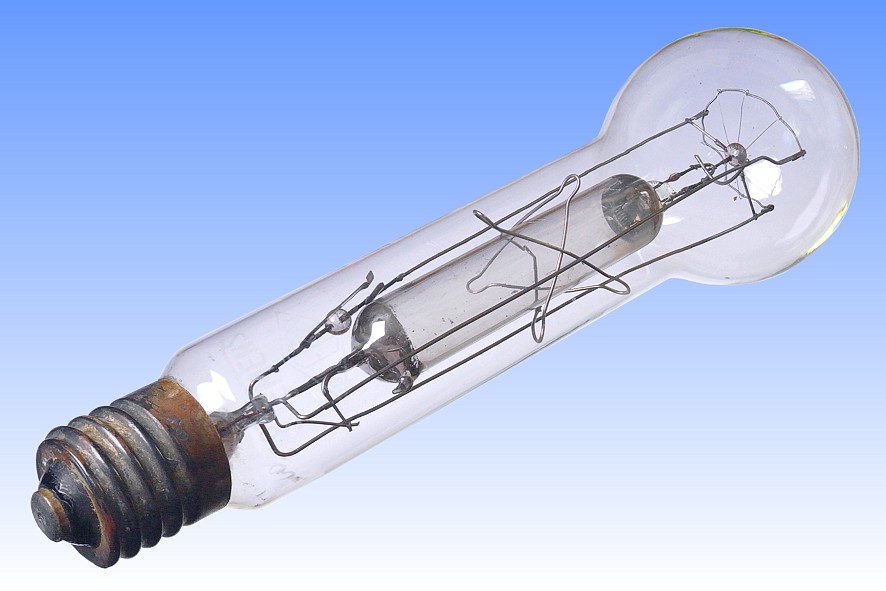
|
Sieray 'Dual' Mercury Blended MAT/V |

The filament performs the triple role of ballasting the discharge, providing instant light at switch-on, and increasing the colour rendering properties. It was a popular light source in industrial installations until the 1940s, when it was superseded by the MBT type quartz mercury lamps.
One difficulty of employing a resistive ballast for a mercury lamp is the fact that the arc voltage changes considerably as the lamp runs up. Initially when the volt drop across the discharge tube is only about 15 volts, the current flowing through the resistance is very high, and in the case of a filament ballast this causes severe over-heating leading to a reduction in life. MAT lamps counteract this weakness by changing the filament resistance as the discharge tube runs up. At first the entire filament length is used, then after a few minutes once the discharge tube voltage has risen, a bi-metallic switch cuts out part of the coil. This construction made MAT lamps rather expensive, and was dispensed with in the later self-ballasted mercury lamps.
The electrodes in this lamp are of a particularly early design. They consist of a tungsten coiled-coil which pre-dates the use of normal oxide emissive coatings. Instead a pellet of radioactive thorium oxide is contained within the coil.



| Manufacturer: | Siemens Electric Lamps & Supplies Ltd. | |
| Lamp Power: | 300 Watts | |
| Lamp Current: | 1.30 Amps | |
| Lamp Voltage: | 250 Volts | |
| Cap Type: | E40s/45 | Brass + vitrite |
| Bulb Type: | GS-80 | GS-25 in eighths/inch |
| Bulb Finish: | Clear | Soda-lime glass |
| Electrodes: | Coiled-coil tungsten | Thoria pellet |
| Arc Length: | 86.9 mm | 3.42 inches |
| Atmosphere: | Hg | Ar (1 atm) | Outer: Nitrogen |
| Luminous Flux: | 6,300 lm (@ 100hrs) | 5,100 lm (@ 2,000hrs) |
| Luminous Efficacy: | 21.0 lm/W (@ 100hrs) | 17.0 lm/W (@ 2,000hrs) |
| Colour Temperature & CRI: | CCT: | CRI: |
| Chromaticity Co-ordinates: | CCx: | CCy: |
| Rated Lifetime: | 2,000 hours | (to 50% survival) |
| Warm-up & Re-strike time: | 5 minutes | 10 minutes |
| Burning Position: | Vertical cap up | |
| Overall Length: | 380 ± 20 mm | 15 inches |
| Light Centre Length: | D:150mm F:245mm | D: 6 inches F: 95/8 inches |
| Factory: | Strand Road, Preston | England |
| Date of Manufacture: | February 1942 | Date Code 24 |
| Original / Present Value: | £3 0s 0d (1945) | £105.90 (2011) |